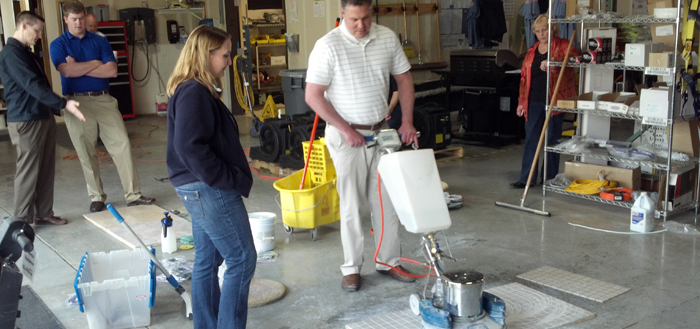By: Mike Anderson, Commercial Equipment Specialist, WAXIE Sanitary Supply

WAXIE Boise CEP Stone Floor Care Training – Cleaning & maintaining various stone flooring materials using a floor machine, as well as the proper cleaning products & accessories.
Floor machines are perfect for using any time you need a scrubber or a mop and you can use them just as you would a vacuum or a mop. Whenever the appearance of your facility is not up to your standards, it’s time to get the floor machine out. Remember, preventative care is much cheaper than restorative care and floor finishes can degrade fast depending on how much foot traffic your floor gets. Cleaning the dirt, debris and sand from your floors regularly will help maintain a brilliant shine.
We generally call them low speeds, but low speed floor machines are also commonly referred to as… swing machines, buffers, side by sides, polishers and scrubbers. In Spanish they refer to it as the “Machina Loca,” which translates to crazy machine – no joke.
A buffer or polisher can also mean a burnisher. So get the name correct.
Keep in mind that the best floor care maintenance program takes several key factors into consideration, the floor machine being just one of them. The others are your flooring material, floor finish, floor pad being used, the amount of foot traffic, as well as your maintenance schedule.
1) Choose a Size
The key to choosing the right size floor machine for your needs is dependent on productivity, which is why a 20-inch floor machine is the most commonly used size. Sometimes you have to go with something a little smaller though, the 13-inch variety is much easier to maneuver around bathroom stalls.
- 20-inch (the most common)
- 17-inch
- 13-inch
2) Choose What Horsepower (HP) You Need
Different cleaning tasks require different speeds. Larger is ALWAYS better in this case. 2 HP is heavy-duty and is the workhorse; it can tackle hard floors & carpeting, whereas a 1 HP machine will have a more difficult time dealing with drag often causing the breakers to trip if too much of a load is put on it. Things to keep in mind.
- 1 HP: Good for normal cleaning
- 1.5 HP: Great for cleaning & stripping floors
- 2 HP: Can do anything & is the best choice for spin bonneting on carpet; using a floor machine on carpet causes more drag, thus you need more power
3) Choose Your Model
175-RPM is typically all one needs from a floor machine, and about 99.5% of all low speed machines are 175-RPM. There is no speed control on the motor. The only time you’d want to choose a dual speed (DS) machine is if you need some sort of polish on the floor. You won’t get the same effect as using an actual floor burnisher, but it is an option, as a DS can go from 175-RPMs for normal cleaning to the 300-RPMs needed for polishing with a flick of the switch.
- Swing Machine/Low Speed: 175-RPM; come in all sizes (13-inch, 17-inch & 20-inch)
- Dual Speed (DS): 175-RPM to 300-RPM; generally only available in the 20-inch size
A NOTE ON ORBITAL TECHNOLOGY: Relatively new floor care cleaning technology. An orbital machine is a cross between an autoscrubber and a traditional floor machine. They have a pad that has small orbits that spin around, allowing the pad to clean the floor in several directions at once. Many machines with orbital technology are very versatile and work on a wide variety of flooring surfaces. There are several types of machines on the market and they all work a little differently.
If You Do Need a Burnisher…
1) Choose a Speed
1500-RPM is generally all that you’ll need. The 2500-RPM has dust control (small passive vacuum action with a paper bag). This is used for the higher speeds, as well as in hospital settings where the slightest dust from a finish can affect a patient.
- 1500-RPM: Most common, works for most jobs
- 2000-RPM to 2500-RPM (ultra high speed): Mostly used for higher solid finishes
2) Choose a Brand
Most brands offer the same warranty, but some offer better ones – you have to ask. Most low speed machines, and burnishers, are meant to last 10-15 years. Keep in mind though, that you get what you pay for. If you want your machine to last longer, go for a higher quality American made one.
If you’re still not sure what type of floor machine or burnisher to get, contact WAXIE. Our Sanitary Maintenance Consultants & Equipment Specialists can come out to your facility and make an on-site assessment of your needs. We can even help you come up with a floor care maintenance program specific for your flooring needs and help train your cleaning staff. We want to help you make your facility cleaner, healthier, greener…and safer.
READ MORE:
5 Tips for Refinishing Your Gym Floor
6 Tips for Giving Your Upright Vacuum Cleaner a Tune-Up
Floor Matting Systems - Protecting Your Investment at the Front Door
Frequency for Cleaning & Maintaining Hard Floor Surfaces
Tackling Grease in Kitchen Grout Lines with the Windsor TAZ



